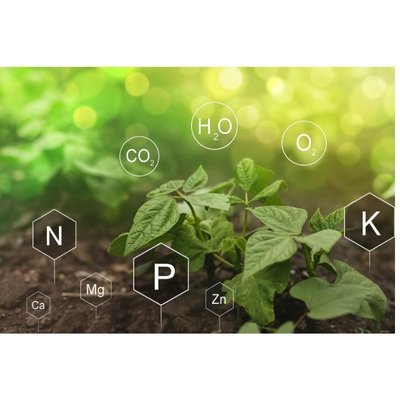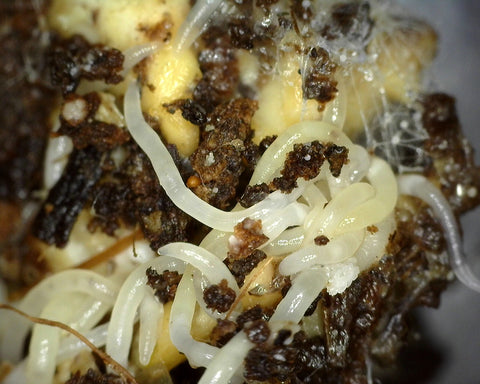
What is the Nutrient Cycle (Nutrient Cycling) in Living Soil
Mark AshworthShare
Nutrient cycling, or the nutrient cycle, is the system in which matter is transferred between the living aspects in your soil and the non-living aspects. The nutrient cycle occurs in a Living Soil System when soil organisms consume nutrients in the soil, defecating (frass) and inevitably dying to give those nutrients back to the soil ecosystem.
In nature, the nutrient cycle is responsible for maintaining most ecosystems around the world. By way of natural, nitrogen-fixing cover crops, soil organisms are able to provide a positive nutrient source back to those plants. The plants are able to exchange carbon in the atmosphere, into nitrogen and when they die, they are consumed by the soil organisms, being turned into plant available nitrogen.
Indoor cannabis requires heavy uptake of nutrients. Being able to defoliate your plant back down into the soil for the soil organisms and microbes to consume, essentially eliminates all unnecessary loss of nutrients in your container. Having nitrogen-fixing cover crops (like clover, cowpeas, legumes) is another way to alleviate other input costs by using the energy and function of your soil food web in the nutrient cycling process.
Since processed, organic inputs are generally more expensive than defoliated plant waste, dry amendments and cover crop seed, there is inherently a cost savings to utilizing nutrient cycling on the most fundamental level.
What Can Help Cycle Nutrients?

Having a variety of composting worms in your living soil containers is absolutely critical to long-term success with nutrient cycling. Not only do worms produce enzymes to breakdown and consume organic matter, but they also help to aerate soil. Red wigglers are the best value as they're one of the most vigorous eaters and reproducers.
Mycelium

Mycelium is a white root-like structure of fungal hyphae that is sometimes so small it is invisible, but also sometimes extraordinarily vast (over thousands of acres). Mycelium assists in nutrient cycle with a it first secreting an enzyme onto organic matter (its food source) which breaks down the biological polymers into smaller monomers. These simpler, smaller monomer units are then absorbed back into the mycelium.
Springtails (Collembola)

Springtails are essential de-composers in your living soil containers. Their presence means that pathogenic bacteria and fungi are being consumed and other, predator species are fed. Read more about Springtails here.
Pot Worms (Enchytraeids)

These small worms are a whitish color and are beneficial to nutrient cycling and the soil food web because they consume fungi, bacteria and organic matter. They are a de-composer, which also help alleviate the risk of pathogens.
Rove Beetles (Dalotia coriaria)

The Rove Beetle (Dalotia coriaria) is a species of soil-dwelling beetles which feeds on fungus gnats, thrips. Some studies have shown that in conjunction with Hypoapsis miles, they can also provide some level of protection against root aphids. They're also detrivores and will consume organic matter, aiding in the decomposition process and helping to cycle nutrients for your plants. Read more about Rove Beetles here.
Looking to add Rove Beetles to your garden? We carry them here!
Stratiolaelaps scimitus (Hypoaspis miles)

The Stratiolaelaps scimitus (Hypoapsis miles) is a soil-dwelling arthropod that is both a predator to pest larva/pupae and a detritivore. The combination of decomposer and predator makes them an essential part of any living soil ecosystem.
Looking to Add More Bio-Diversity to Your Soil? Checkout our Living Soil Bio-Diversity packs which come loaded with Rove Beetles, Hypoapsis miles and other decomposing species to get your living soil bed cranking.
Read More About These Key Soil-Based Beneficial Insects
- Oribatid Mites (Oribatida)
- Rove Beetles (Dalotia coriaria)
- Stratiolaelaps scimitus (Hypoaspis miles)
- Springtails (Collembola)
- Red Wiggler Worms (Eisenia Fetida)
- Enchytraeidae (Pot Worms)
Checkout These Helpful Guides
- How To Release Your Living Soil Bio-Diversity Pack
- How To Manage Grey Potato Bugs in Living Soil Containers
- How to Make Sprouted Seed Tea with Blue Corn
- How To Use Coconut Powder in the Garden
- How to Use Aloe in the Garden
